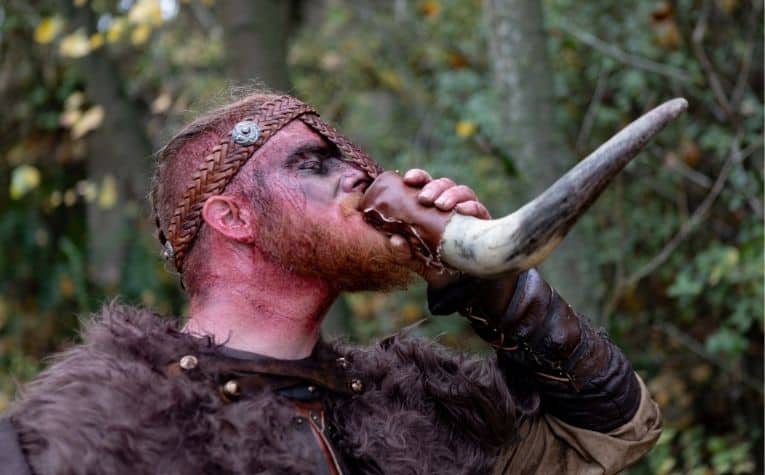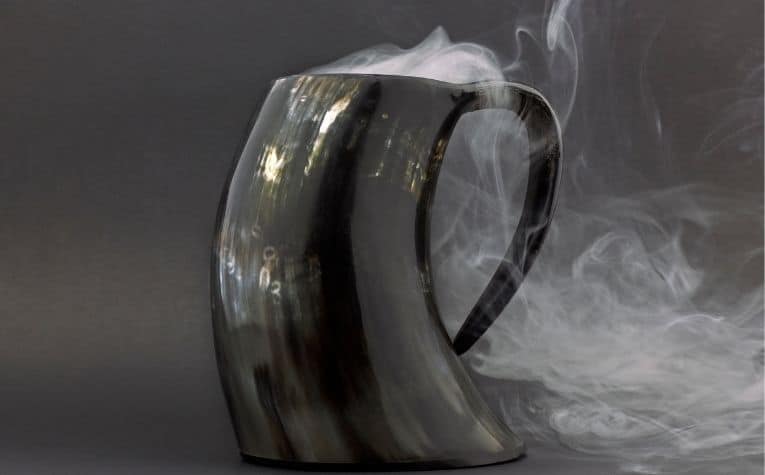Even though their reign lasted but a few centuries, the Vikings left a lasting mark on history.
They have been portrayed (sometimes unfairly) as ultra-violent people with a penchant for targeting monasteries and attacking coastal towns.
Their fighting skills on the battlefield are as legendary as the gods and heroes they worshiped.
Viking ale was made with three simple ingredients: water, barley, and yeast.
The drink was a significant beverage not only for ceremonial purposes like toasting to Norse deities but also as an essential staple that was perhaps as vital to the Viking way of life as the swords they wielded.
So how did the Vikings make their ale? Scholars and historians have a pretty good idea.
The Vikings are portrayed in different ways in modern art. See What Did the Vikings Really Look Like? to get the facts.

The Essentials of Viking Ale
The Vikings are perceived as a people who enjoyed sharing libations over stories of victory against hated foes or in celebration of bountiful harvests their gods bestowed upon them.
The task of beer-making was largely left to Viking women as virtually anything related to maintaining the homestead fell within their domain.
As such, Viking brewmasters were all female, and each domicile likely had its own recipe for ale, producing unique flavors and characteristics that varied from household to household.
But as diverse as Viking ales throughout Scandinavia may have been, they all shared in common the vital ingredients of barley and yeast. (Also see What Did the Vikings Eat?)
Viking Ale was Made with a Native Barley
The particular type of barley used by Vikings to make their ale is known as six-rowed barley and has been identified by historians as having been grown in various parts of Scandinavia since the Stone Age.
This barley also goes by the name bere (pronounced bear) grain. Of the two types of six-rowed barley, naked and normal, the former was of particular importance during the Viking Age.
Aside from brewing beer, six-rowed barley was also used by the Vikings to prepare staple items like bread and grits (porridge). [1]
The Vikings weren’t always as serious. See Here is What the Vikings Did for Fun to learn more.

Vikings Mastered the Use of Wild Yeast
The Vikings successfully harnessed the fermenting power of wild yeast even though they did not know (nor did anyone during the Middle Ages) what the microorganism was or how it worked.
They knew that the mysterious substance was vital to transforming malted barley and water into the ale they consumed daily.
The Vikings also learned that the yeast could be re-used from one batch of ale to prepare the next. This could be done in several ways [2]:
- A gob of actively fermenting yeast could be removed from one batch of ale and set aside to start the next batch.
- Placing a dried out log (usually cut from a juniper or birch tree) into the bottom of a batch would cause yeast to accumulate in its nooks and cracks. Dropping this yeast log into later batches of ale would result in faster and more thorough fermentation in these subsequent brews.
- Similarly, re-using the same stick to stir the fermenting mixture would result in the transfer of yeast, as would re-using the same, unwashed fermentation vessel.
How the Vikings Made Ale
Alcohol was an important part of Viking culture on multiple levels:
- It was a daily staple that every Viking drank and was even consumed by children (albeit with far lower alcohol content than the grown-up version). This may have largely been because as ale was boiled during its preparation (and hence, sterilized), it was safer to drink than most water supplies during that time.
- It was a vital component of nearly all rituals, including funeral ceremonies and sacrificial rites.
- It was even an important symbolic gesture that completed transactions like marriages and sales contracts.
It should come as no surprise, therefore, that the Vikings not only mastered the art of making ale, it became second nature to them and was as much a part of their regular routine as working their fields and hunting for food.
A lot of people wonder what the Vikings looked like. See Did Vikings Have Piercings? to learn more.

Viking Ale Began with Preparing the Mash
Every batch of Viking ale began with preparing the mash, which consisted of combining malted barley and water in a large vessel and heating the mixture over an open flame.
It was this process that primed the natural starches present in the barley to be transformed into sugars that would get the fermentation engine going.
Regarding the type of vessel used to make Viking ale, theories abound, but the consensus appears to be earthenware vessels or large troughs, possibly dug into the ground.
The Mash Becomes a Wort
The heating of mash resulted in a liquid extract consisting of water and various compounds removed from the barley, known as the wort. In essence, the wort was pre-fermented beer or the beer starter.
It contained all the necessary sugars that would be converted to alcohol once the yeast was introduced to the mixture and fermentation began in earnest.
It is worth noting that the Vikings were known to make and drink ales of varying strengths (alcohol content), depending on the occasion.
For everyday drinking, with meals, for instance, ale with a lower ABV (alcohol by volume) would be consumed.
For feasting or ceremonial events, ale with a higher ABV would be appropriate.
Although it is impossible to say definitively just how strong or weak Viking ales truly were, reasonable approximations of their ABVs would be:
- For lighter Viking ales, as low as 2.6% ABV
- For stronger Viking ales, as high as 13% ABV
The Vikings could manipulate their ale brews’ alcohol content by controlling the amount of water that was mixed with the barley when preparing the mash.
A dry mash (less water) would result in ale with a higher ABV, while the opposite would be true with a wet mash (more water).
Fermenting Viking Ales
Modern homebrewers can run down to their local homebrew supply store and purchase yeast for making beer.
Centuries ago, the Vikings had to rely on mother nature to provide the yeast, and this was typically done by simply leaving the warm mixture uncovered out in the open air, or better yet, underneath the branches of a fruit-bearing tree (where yeast would naturally collect on the fruit).
Once the yeast was successfully introduced into the wort, the resulting fermentation process would quickly transform the soggy mixture into ale. The finished brew was then transferred into vessels for storing and serving.
The milder version of Viking ale that children consumed was prepared by using the spent barley that remained after the completion of the main batch.
It is worth noting that the particular strain of yeast that was native to Scandinavia (specifically Norway) during the Viking Age came to be known as Kveik yeast, and traces of it still exist to this day.
In fact, Norwegian Kveik yeast is still used in small microbrew setups in Norway and can be purchased by those willing to pay its steep asking price. [3] [4] [5] [6]
What did Vikings consume during ceremonial rituals? See Did Vikings Really Drink Blood? to learn more.
The Role of Ale in Viking Society
Vikings are forever bound to the imagery of savage warriors laying waste to opposing armies throughout Northern Europe during the Middle Ages.
Still, the reality is that most citizens of Scandinavia (Norway, Sweden, and Denmark) during the Viking Age were simple farmers.
In fact, when they were not away on raids or engaged in conquests of distant lands, even Viking warriors traded in their swords for shovels.
The ale that the Vikings brewed to consume during their blot (sacrificial) rituals or with their nightly supper could be described as what is today known as a farmhouse ale.
This term refers to beer brewed with rustic technology and producing an unrefined, non-commercial beverage.
In other words, the Vikings brewed beer using grains harvested from their own farms with the available means.
Based on what scholars know about Viking rituals and social practices where upwards of 50 men would sit together, they would have brewed fairly large batches of ale.
So, the Vikings presumably used large earthenware vessels or troughs, as metal kettles would have been prohibitively expensive.
Regardless of the setting or the number of partakers, Viking ale was a unifying force.
From its production to consumption, Viking Age beer was consumed by people of all ages, for any occasion, and under any circumstance. [7] [8]
Conclusion
The Vikings lived through harsh times and conditions, and the ale they brewed was far more than a ceremonial beverage. It was an essential staple.
Women had a unique role in Viking society. See Did Female Vikings Go on Raids? to learn more.
References:
[1] Source
[2] Source
[3] Source
[4] Source
[5] Source
[6] Source
[7] Source
[8] Source
